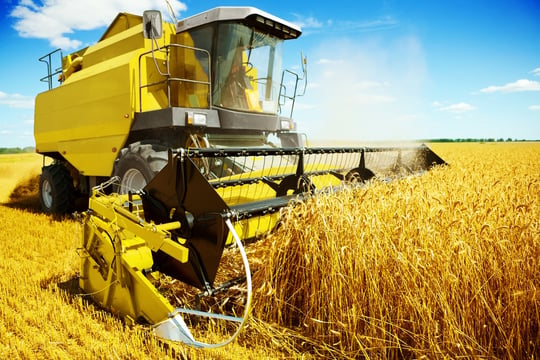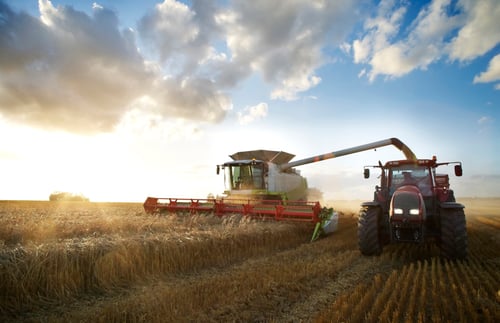The best distance sensors for the agricultural sector

It has been repeatedly proven that distance sensors contribute to precision agriculture. In fact, with the help of technology, crops and animals can be treated well and with precision. Smartly and efficiently. Measuring is knowing, and farmers who practice smart farming are discovering how they can benefit from this when it comes to generating more food with less manual labor. But when is it best to choose one distance sensor over another and how do you choose the right distance sensor? In this blog, we zoom in on how to select the best distance sensor and how to use these sensors, and include a few practical examples.
Global population growth, looming food shortages, and scarcity of workers are major issues today. Be it in agriculture or livestock farming, smart farming and sustainable food production using new technologies are no longer a choice, but an obligation. With smart distance sensors in your machines, you make smart farming a lot more tangible and applicable for your customers. And of course they have to be capable of direct integration, be watertight and able to withstand heavy contamination.
Choosing the right distance sensor
When choosing the right distance sensor, it is important to ask the right questions. That starts with the application. What do you want to measure? And in what kind of environment do you need to make that measurement? On what kind of machine? Under what conditions? What will be done with the measurement data? Once you know that, you can delve deeper. How accurately do you want to measure? What exactly should that measurement look like? Fast or slow? A centimeter or a meter? All of these functional specifications are critical when choosing a distance sensor. That's why it is wise to write a set of technical specifications. That document will contain all the factors relating to the environment, the materials, the conditions and even the worst-case scenarios. You can either do that yourself, or together with a sensor specialist. Thanks to years of experience in the industry, the specialists at Sentech know without fail how to ask the right questions, how to look critically at a situation and an environment, and determine the right sensor.
When is it best to choose one distance sensor over another?
This varies depending on the field and application. The best distance sensors for agriculture and horticulture are currently radar, ultrasonic and LiDAR. Here, we will briefly explain how each sensor technology works.-
Ultrasonic
These sensors work based on time of flight: the sensor calculates the distance to the object by reflecting a high-frequency signal on it. Even with uneven surfaces, reflective liquid surfaces and glass, you can expect reliable measurement results thanks to the narrow sound cone. Sound is resistant to dust and moisture, and also the high level of sealing up to IP68 makes this distance sensor suitable for dusty and humid environments such as fields. Ultrasonic sensors are often used in agricultural vehicles to measure crop heights or fill levels for liquids. You can read about more practical examples later in this article. Read more about our ultrasonic sensors here.
-
Radar
Radar sensors also operate based on a high-frequency transmitter signal, but for the time of flight principle they use very high-frequency radio signals in the GHz band instead of light or sound. The various high frequencies all have unique properties. Radio waves have very high penetration capabilities. This means that they not only see the top of crops, for example, but also the different layers of leaves as well as the soil. In other words, this practically lets you see through the crops! Radio waves can measure unobstructed distances to buildings, objects and liquids. That makes this distance sensor suitable for applications such as fluid level measurements, distance measurements and object detection. Just like ultrasonic sensors, radar sensors are suitable for applications in harsh environments. Radar is not affected by contamination or wind and is therefore ideal for measuring distances on land when you are not dealing with transparent or liquid surfaces. Long distances and surfaces that vary greatly in shape are no problem at all for radar. Take, for example, when the fill rate of a silo needs to be measured. In this case, these sensors have an edge over ultrasonic. Read more about our radar sensors here.
-
Lidar
This optical measuring technology can be applied in two ways: Time-of-flight lidar determines the distance to an object and Doppler lidar determines the speed of objects. It works in a similar way to radar, but it uses laser light instead of radio waves. Light has a much smaller wave length, enablinglidar to detect and scan smaller objects. The light transmitted is reflected by the target. This sensor calculates the distance based on the time between sending and receiving. All machines and vehicles that move autonomously need this distance measurement. Lidar has its roots in aerospace for good reason, and car manufacturers are also embracing the advantages of these sensors for autonomous driving applications. For example, lidar is used in automated guided vehicles (AGVs) and in autonomous mobile robots (AMRs). This is because lidar continuously and flawlessly maps the environment and any obstacles while driving. In the agriculture sector, too. After all, with agricultural machinery, it is good to know if a tree is still 5 meters or 5 centimeters away from the equipment and whether or not a cow is passing by. Lidar is accurate when it comes to small objects and sees more detailed differences than radar, so it is an ideal solution for machines that drive autonomously. Read more about our lidar sensors here.
These distance sensors are currently the most widely used on agricultural farms. When is it best to choose one distance sensor over another? That depends on a lot of different factors, such as the environment and the application. Every issue calls for a different sensor. Or perhaps a combination of two technologies is the ideal solution, as radar and lidar complement each other perfectly. That is what we call sensor fusion. A sensor specialist can help you make the right choice.
Practical examples in agricultural businesses
And then the practical situation. Apart from allowing agricultural vehicles to drive autonomously and work the land, you can use distance sensors for an incredible number of applications. We'll walk you through a few helpful examples. Autonomous machines not only drive on land, but an increasing number of robots are also moving around in greenhouses to care for plants or to bring in the harvest. Farmers can also use distance measurement to measure height for spraying systems: How high is the boom sprayer above the soil and how high above the crop? Another example is checking plant density.
Some farmers even measure the height of the grass and how fast it is growing so they can better assess when it is best to mow. Or they measure the feed levels when feeding the cows. And how much milk is in the storage tank? Yet another example is fill rate measurement. You can measure how full a feed silo is by using an ultrasonic or a radar solution. When it is almost empty, the sensor automatically signals the supplier to bring a new batch of feed. The farmers themselves no longer have to worry about it. These were just a few convenient applications – the possibilities are endless. That is innovative farming and livestock farming.
Want to know more about the best distance sensors?
Distance sensors are mainly about measuring distances, fill rates, lengths or calculating volumes. After writing a well-thought-out set of technical specifications, you will be able to make the right choice. Our advice is to always do this together with a specialist. That way you can always be sure that all of the details have been thought through beforehand, and not only afterward when the machine is already driving over the fields.
Are you looking for the smartest technologies for your machine and want customized advice? Then call in a specialist. You can read why this always pays off here. At Sentech, we have years of experience in this sector and are happy to work with you to find the ideal solution.


.png)

